Submarine Rescue on:
[Wikipedia]
[Google]
[Amazon]
 Submarine rescue is the process of locating a sunk
Submarine rescue is the process of locating a sunk
 The original strategy for surviving a submarine accident was to escape. The first escape systems were based on a
The original strategy for surviving a submarine accident was to escape. The first escape systems were based on a 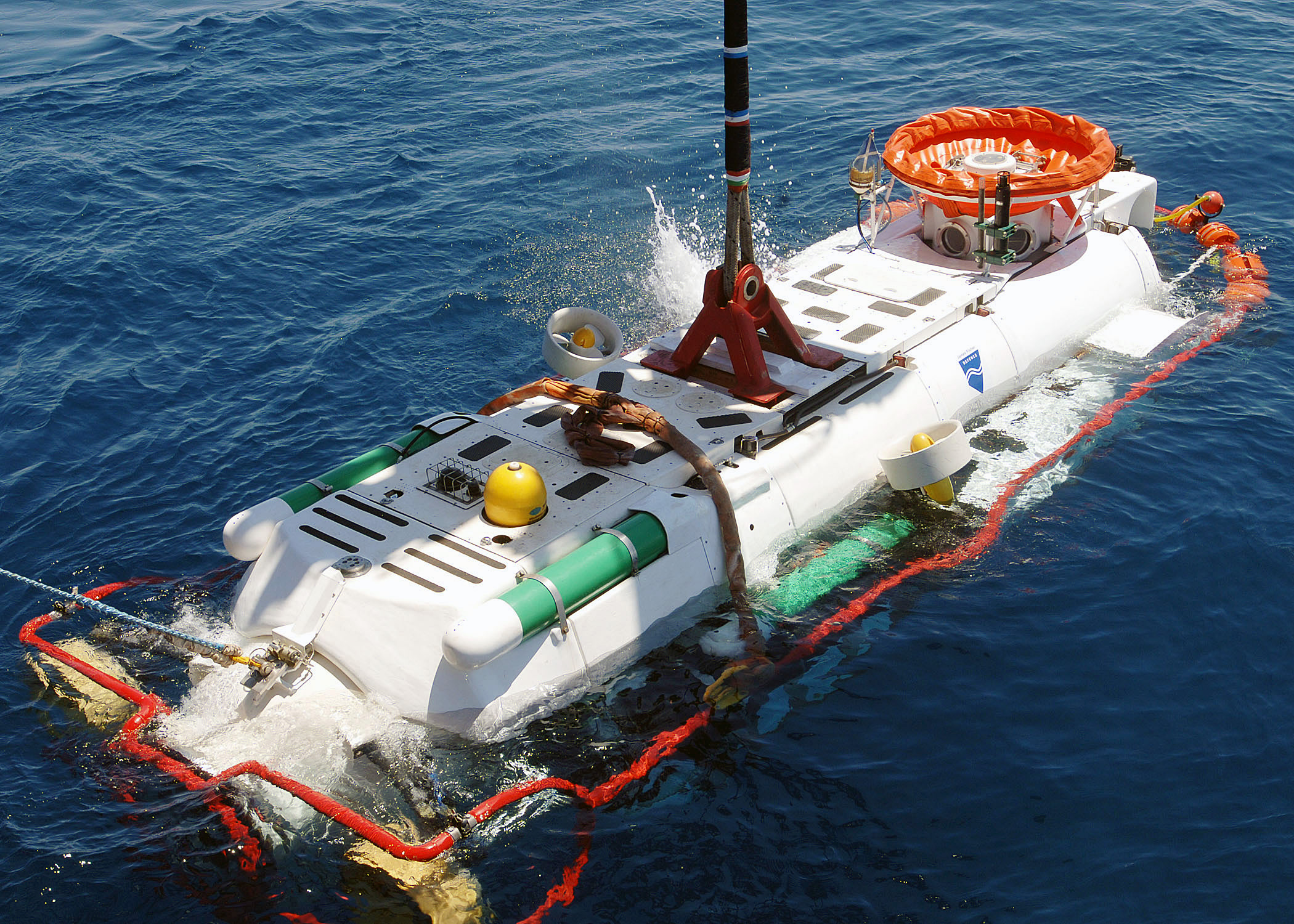 Other navies followed this example and developed their own portable rescue capabilities. The Royal Navy’s LR5 Submarine Rescue Vehicle uses a surface
Other navies followed this example and developed their own portable rescue capabilities. The Royal Navy’s LR5 Submarine Rescue Vehicle uses a surface
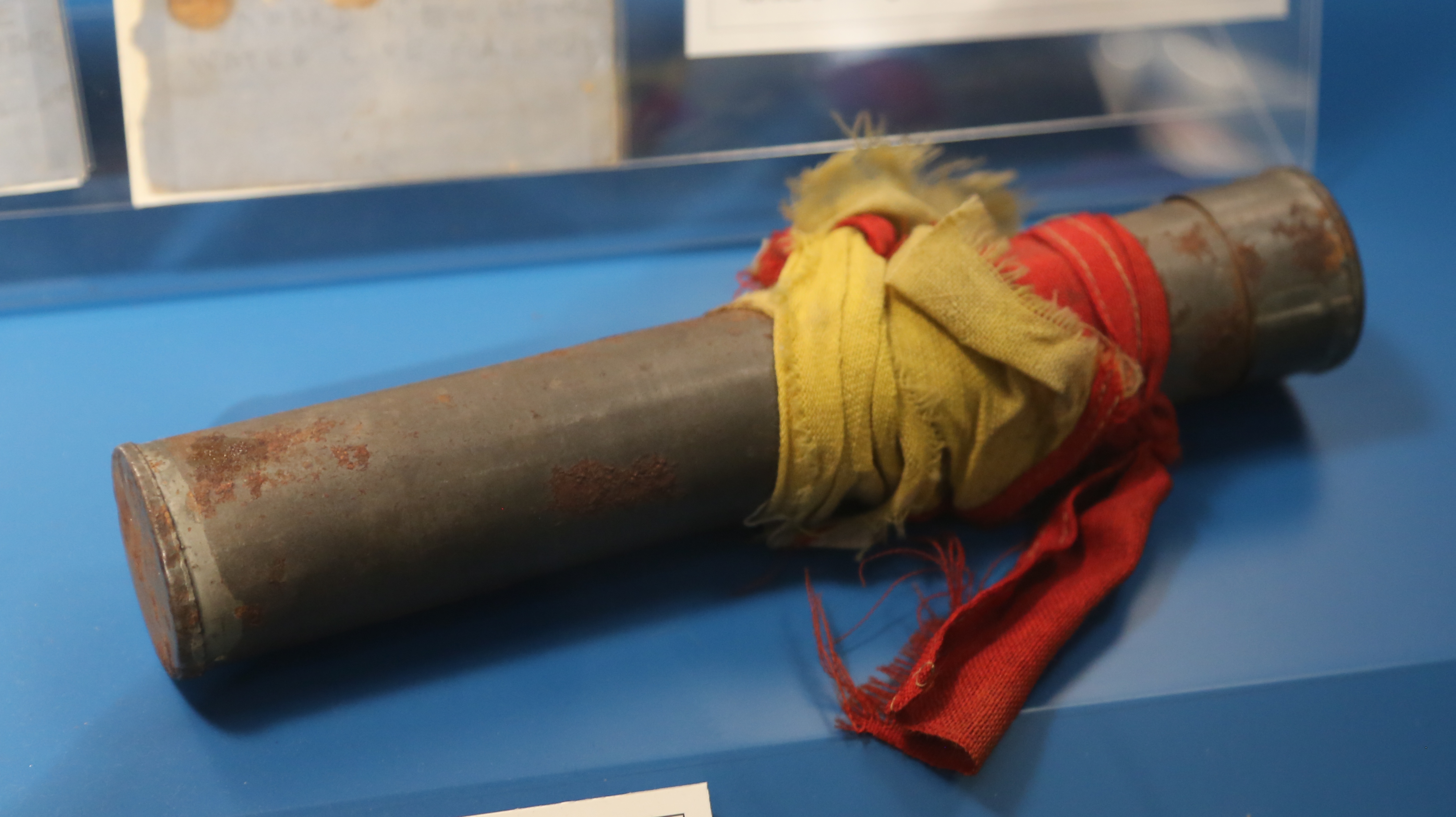 1917: On 29 January 1917, the submarine HMS ''K13'' sank in the
1917: On 29 January 1917, the submarine HMS ''K13'' sank in the
 Submarine Escape Immersion Equipment (SEIE) allows individual escape from a distressed submarine. It is a waterproof, insulated suit with a breathing system and buoyancy control to safely bring crew to the surface, protecting against cold and decompression risks.
Submarine Escape Immersion Equipment (SEIE) allows individual escape from a distressed submarine. It is a waterproof, insulated suit with a breathing system and buoyancy control to safely bring crew to the surface, protecting against cold and decompression risks.
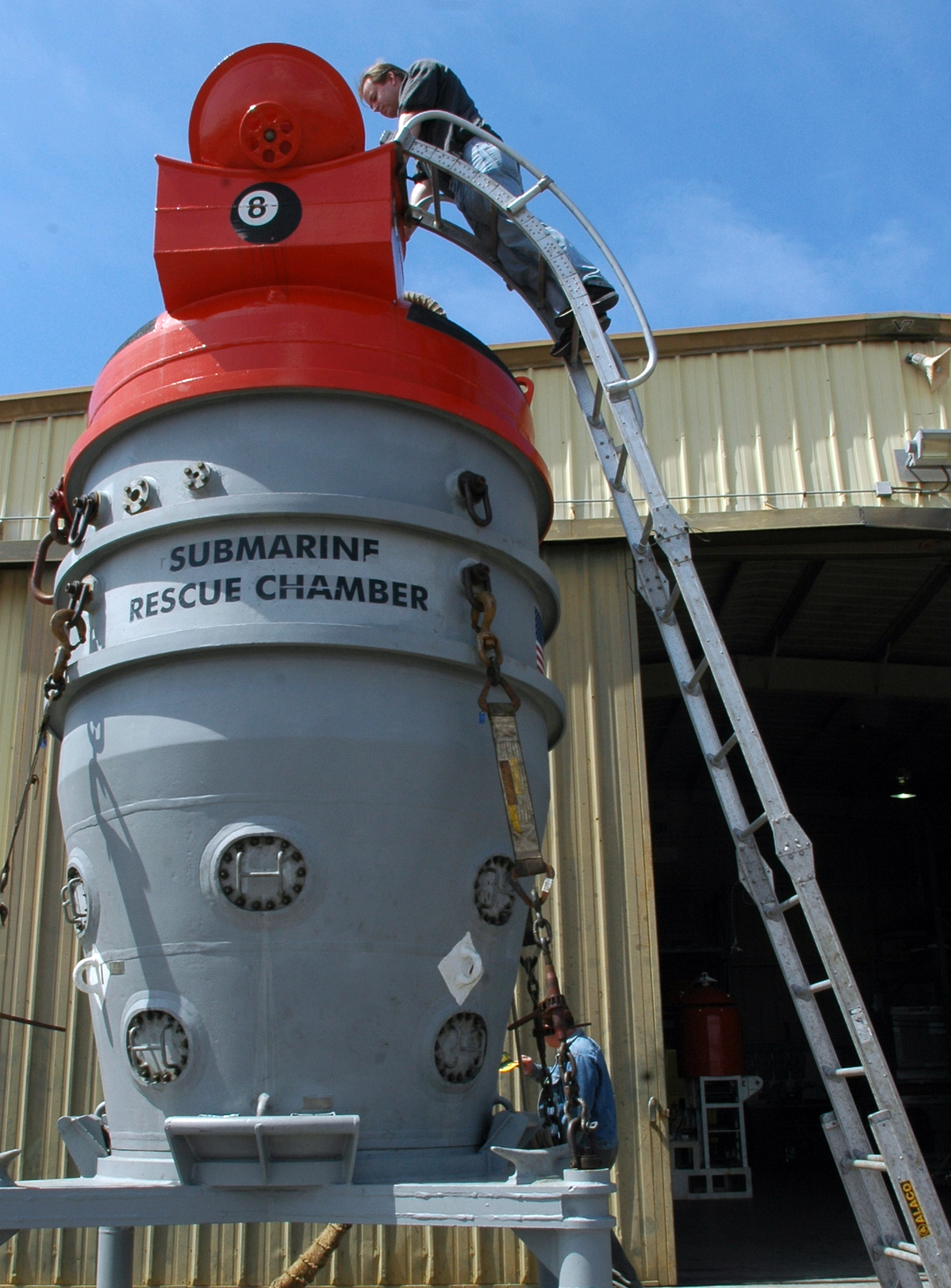 Diving bells have been used for submarine rescue. The closed dry bell is designed to seal against the deck of the submarine above an escape hatch. Water in the space between the bell and the submarine is pumped out and the hatches can be opened to allow occupants to leave the submarine and enter the bell. The hatches are then closed, the bell skirt flooded to release it from the submarine, and the bell with its load of survivors is hoisted back to the surface, where the survivors exit and the bell may return for the next group. The internal pressure in the bell is usually kept as close as possible to atmospheric pressure to minimise run time by reducing or eliminating the need for decompression, so the seal between the bell skirt and the submarine deck is critical to the safety of the operation. This seal is provided by using a flexible sealing material, usually a type of rubber, which is pressed firmly against the smooth hatch surround by the pressure differential when the skirt is pumped out.
The McCann Submarine Rescue Chamber uses a cable attached to a
Diving bells have been used for submarine rescue. The closed dry bell is designed to seal against the deck of the submarine above an escape hatch. Water in the space between the bell and the submarine is pumped out and the hatches can be opened to allow occupants to leave the submarine and enter the bell. The hatches are then closed, the bell skirt flooded to release it from the submarine, and the bell with its load of survivors is hoisted back to the surface, where the survivors exit and the bell may return for the next group. The internal pressure in the bell is usually kept as close as possible to atmospheric pressure to minimise run time by reducing or eliminating the need for decompression, so the seal between the bell skirt and the submarine deck is critical to the safety of the operation. This seal is provided by using a flexible sealing material, usually a type of rubber, which is pressed firmly against the smooth hatch surround by the pressure differential when the skirt is pumped out.
The McCann Submarine Rescue Chamber uses a cable attached to a
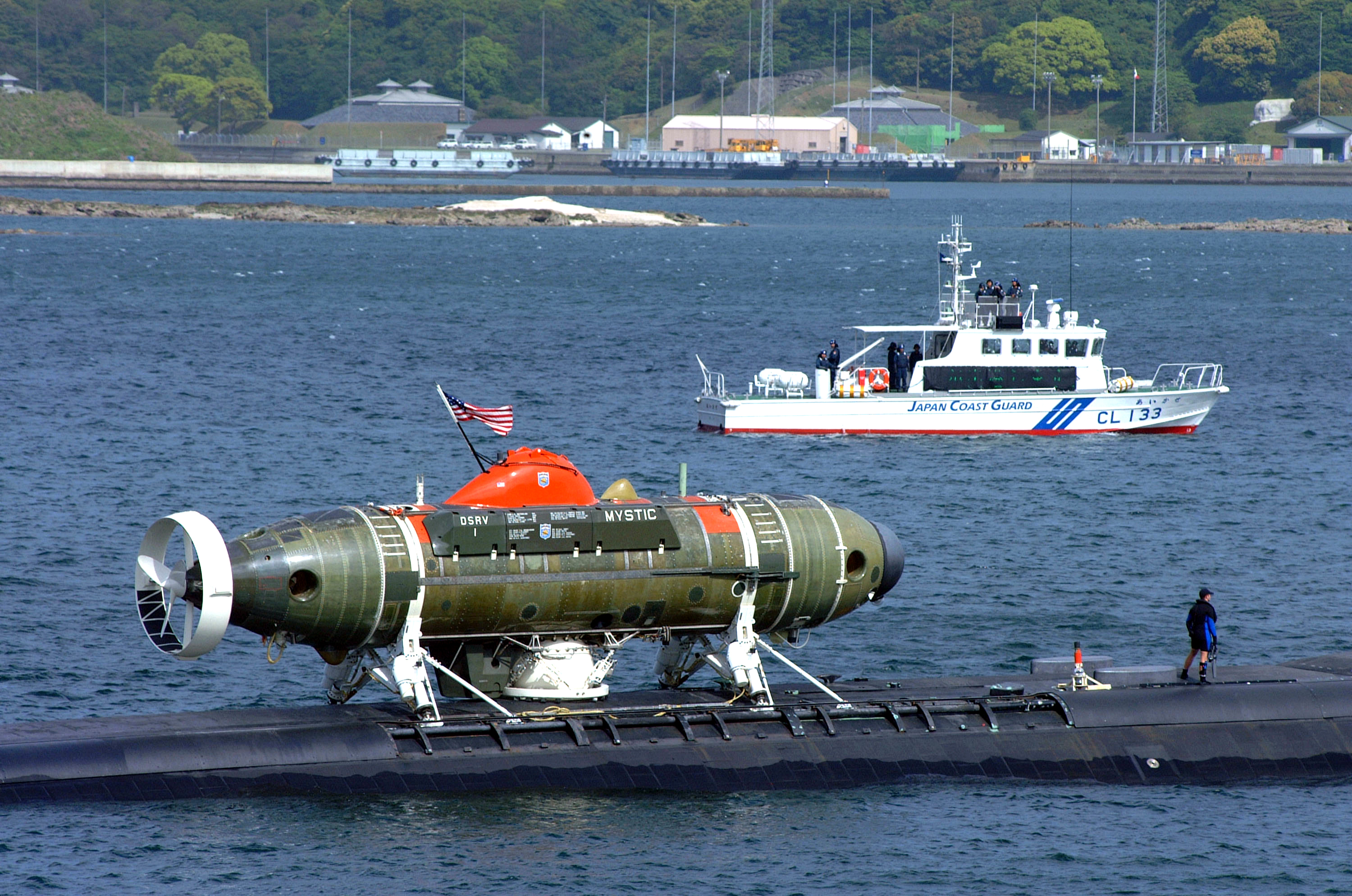
 A deep-submergence rescue vehicle (DSRV) is a type of
A deep-submergence rescue vehicle (DSRV) is a type of
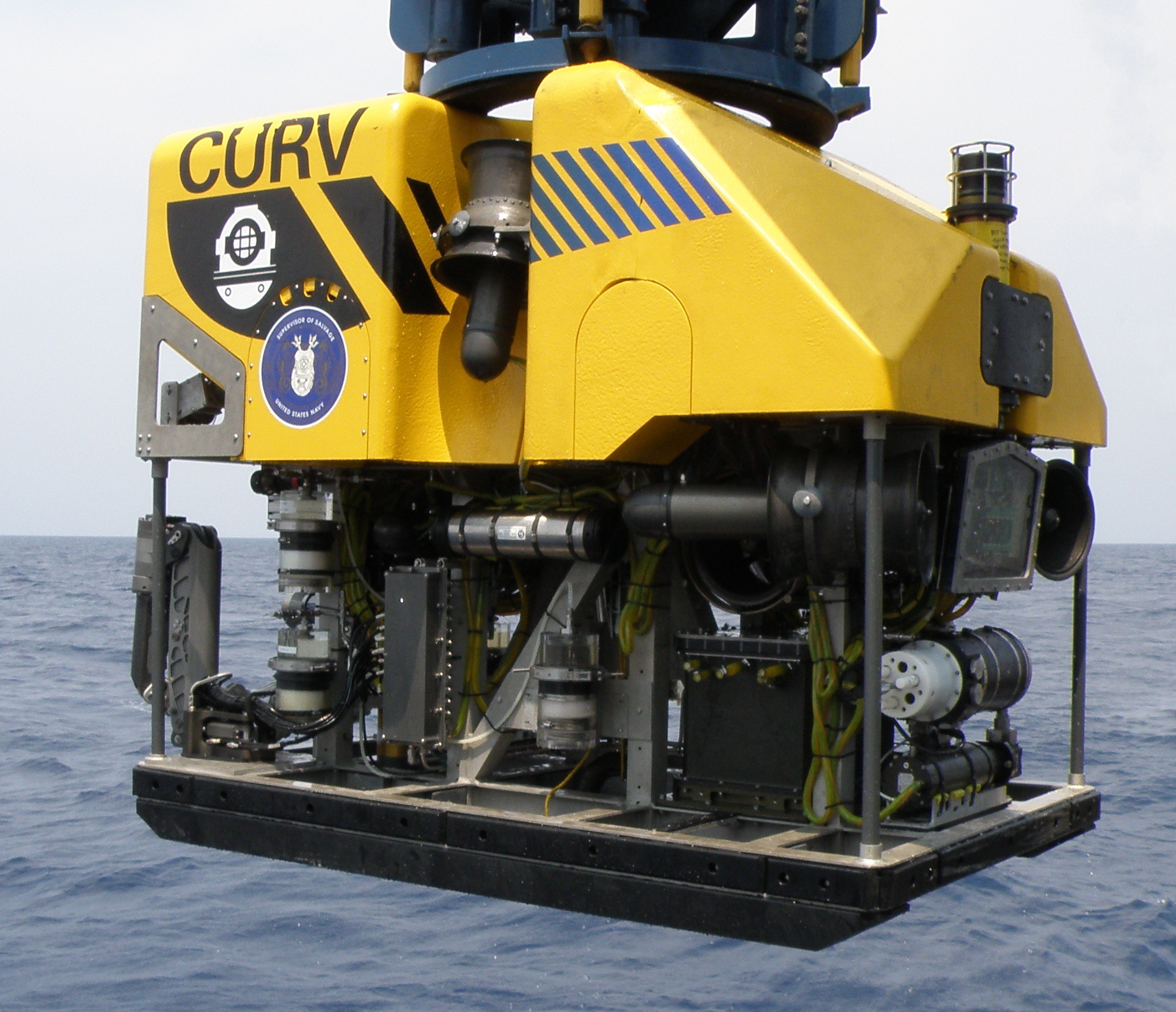 Remotely operated underwater vehicles (ROVs)
Remotely operated underwater vehicles (ROVs)
 Submarine rescue is the process of locating a sunk
Submarine rescue is the process of locating a sunk submarine
A submarine (often shortened to sub) is a watercraft capable of independent operation underwater. (It differs from a submersible, which has more limited underwater capability.) The term "submarine" is also sometimes used historically or infor ...
with survivors on board, and bringing the survivors to safety. This may be done by recovering the vessel to the surface first, or by transferring the trapped personnel to a rescue bell or deep-submergence rescue vehicle
A deep-submergence rescue vehicle (DSRV) is a type of deep-submergence vehicle used for rescue of personnel from disabled submarines and submersibles. While DSRV is the term most often used by the United States Navy, other nations have different ...
to bring them to the surface. Submarine rescue may be done at pressures between ambient at depth, and sea level atmospheric pressure, depending on the condition of the distressed vessel and the equipment used for the rescue. Self-rescue of submarine personnel by buoyant free ascent at ambient pressure is considered submarine escape. Survivors may require recompression treatment for decompression illness
Decompression Illness (DCI) comprises two different conditions caused by rapid decompression of the body. These conditions present similar symptoms and require the same initial first aid. Scuba divers are trained to ascend slowly from depth to av ...
.
National and international services exist to facilitate the rapid response to submarine emergencies, including the NATO Submarine Rescue System
The NATO Submarine Rescue System (NSRS) is a tri-national project to develop an international submarine rescue system. The system provides a rescue capability primarily to the partner nations of France, Norway and the United Kingdom, but also to ...
, and within the US navy the Undersea Rescue Command (URC).
History
 The original strategy for surviving a submarine accident was to escape. The first escape systems were based on a
The original strategy for surviving a submarine accident was to escape. The first escape systems were based on a mining
Mining is the Resource extraction, extraction of valuable geological materials and minerals from the surface of the Earth. Mining is required to obtain most materials that cannot be grown through agriculture, agricultural processes, or feasib ...
breathing apparatus, which was a primitive form of rebreather using a soda-lime scrubber. The system used in the first escape from a sunk submarine was the German Dräger breathing apparatus, used when the submarine ''U3'' sank in 1911. Similar systems, such as the Royal Navy's Davis Submerged Escape Apparatus
The Davis Submerged Escape Apparatus (also referred to as DSEA), was an early type of oxygen rebreather invented in 1910 by Robert Davis (inventor), Sir Robert Davis, head of Siebe Gorman, Siebe Gorman and Co. Ltd., inspired by the earlier Fleuss ...
, and the United States Navy's Momsen lung
The Momsen lung was a primitive underwater rebreather used before and during World War II by American submariners as emergency escape gear. It was invented by Charles Momsen, who worked on it from 1929 to 1932. Submariners trained with this appar ...
, were adopted soon after. In 1946 an investigation by the RN found that there was no difference in survival rate between using an escape apparatus and an unaided ascent, so the free ascent was officially adopted. Free ascent required the submariner to keep an open airway throughout the ascent to avoid lung overpressure injury due to air expansion with decreasing ambient pressure.
The USN adopted the Steinke hood
A Steinke hood, named for its inventor, Lieutenant Harris Steinke, is a device designed to aid escape from a sunken submarine. In essence, it is an inflatable life jacket with a hood that completely encloses the wearer's head, trapping a bubble ...
in 1962, which is a hood with a transparent viewport attached to a life jacket, which allowed the user to rebreathe air trapped in the hood during the ascent. Free ascent and the Steinke hood were simple, but provided no environmental protection once the submariner surfaced, and many submariners in the HMS ''Truculent'' and ''Komsomolets'' incidents died at the ocean's surface due to hypothermia
Hypothermia is defined as a body core temperature below in humans. Symptoms depend on the temperature. In mild hypothermia, there is shivering and mental confusion. In moderate hypothermia, shivering stops and confusion increases. In severe ...
, heart failure
Heart failure (HF), also known as congestive heart failure (CHF), is a syndrome caused by an impairment in the heart's ability to Cardiac cycle, fill with and pump blood.
Although symptoms vary based on which side of the heart is affected, HF ...
, or drowning. During the 1990s most of the world’s navies using submarines replaced their escape systems with the British Submarine Escape Immersion Equipment
Submarine Escape Immersion Equipment (SEIE), also known as Submarine Escape ''and'' Immersion Equipment, is a whole-body suit and one-person life raft that was first produced in 1952. It was designed by British company RFD Beaufort Limited and a ...
, or a variation. The SEIE is rated for escape from 185m, covers the user completely, and provides thermal protection and integral flotation that can be linked to other units on the surface.
Some rescues involving recovering the whole submarine to the surface were made, but this required ideal conditions, and more often failed. The successful USS ''Squalus'' rescue using the McCann Rescue Chamber
The McCann Submarine Rescue Chamber is a device for rescuing submariners from a submarine that is unable to surface.
History
During the first two decades of the United States Navy Submarine Force, there were several accidents in which Navy submar ...
in 1939 showed that deep rescue is possible, and provided a redirection in survival strategy thinking.
Built-in escape pods have been investigated by the Russian Navy, and were considered by the US Navy before they decided on a system of deep submergence rescue vehicles which entered service during the 1970s. These were small crewed submarines which could be carried by another submarine, and deployed underwater, making them largely unaffected by surface weather conditions. The first models for the USN could carry 24 survivors. and could be airlifted to a port near to the disabled submarine and mounted on a compatible submarine vessel of opportunity.
vessel of opportunity
Vessel(s) or the Vessel may refer to:
Biology
*Blood vessel, a part of the circulatory system and function to transport blood throughout the body
*Lymphatic vessel, a thin walled, valved structure that carries lymph
*Vessel element, a narrow wat ...
as the base of operations, and operates in conjunction with the Submarine Parachute Assistance Group
The Royal Navy's Submarine Parachute Assistance Group (SPAG) is a team who provide a rescue support capability to submarine sinking incidents worldwide, available at short notice.
History
The Submarine Parachute Assistance Group was originally ...
and the Scorpio ROV
The Scorpio (Submersible Craft for Ocean Repair, Position, Inspection and Observation) is a brand of underwater submersible Remotely Operated Vehicle (ROV) manufactured by Perry Tritech used by sub-sea industries such as the oil industry for gen ...
. The SPAG team are set up to parachute into the water at the location of the incident along with air-dropped equipment pods containing rigid-hulled inflatable boats, life rafts, food, water and medical supplies to support survivors evacuating the sunken submarine.
The LR5 and DSRV were due to be replaced the end of 2008. The USN developing the Submarine Rescue Diving Recompression System
The Submarine Rescue Diving Recompression System (SRDRS) is a remotely operated underwater vehicle and its associated systems intended to replace the ''Mystic'' class deep submergence rescue vehicle as a means of rescuing United States Navy sub ...
and the LR5 replaced by the similar NATO Submarine Rescue System
The NATO Submarine Rescue System (NSRS) is a tri-national project to develop an international submarine rescue system. The system provides a rescue capability primarily to the partner nations of France, Norway and the United Kingdom, but also to ...
, a joint project of Britain, France and Norway. These systems are similar in concept to the Royal Australian Navy's Australian Submarine Rescue Vehicle ''Remora'', and carry out rescue operations in three phases: reconnaissance and possibly site preparation or delivery of emergency supplies by ROV, rescue by deep-submergence rescue vehicle, and crew decompression when needed after transfer under pressure to a surface decompression chamber. There is a trend towards larger capacity rescue vehicles, which will reduce the number of locking on operations and recoveries from the water necessary.
After the ''Kursk'' submarine disaster of 2000, the International Submarine Escape and Rescue Liaison Office (ISMERLO) was formed in 2003 to help coordinate international submarine rescue operations.
During the recent ''Titan'' incident, discussions surrounding the possible salvaging of the submersible were raised by maritime entities; Officials forwarded proposals for the transportation of the DSV ''Limiting Factor towards the last known location before diving down in search and discovery attempts, an approach that would have costed millions. Some however disputed the suggestion, since the time quantity for the ''Limiting Factor'' to arrive, transportation logistics of the submersible to the location along with the length to rescue as well as recover ''Titan'' led some to doubt its overall feasibility. Others recommended the consideration of the remaining oxygen on board ''Titan''. Despite the efforts, the ''Titan'' was later discovered within wreckage the subsequent days.
Timeline of successful submarine rescues
*Gareloch
The Gare Loch or Gareloch () is an open sea loch in Argyll and Bute in the west of Scotland, and it bears a similar name to the village of Gairloch in the north west Highlands.
The loch is well used for recreational boating, water sports an ...
in Argyll and Bute
Argyll and Bute (; , ) is one of 32 unitary authority, unitary council areas of Scotland, council areas in Scotland and a lieutenancy areas of Scotland, lieutenancy area. The current lord-lieutenant for Argyll and Bute is Jane Margaret MacLeod ...
, Scotland
Scotland is a Countries of the United Kingdom, country that is part of the United Kingdom. It contains nearly one-third of the United Kingdom's land area, consisting of the northern part of the island of Great Britain and more than 790 adjac ...
, during sea trials with 80 people on board. About 10 hours later a vessel deployed divers who were able to communicate with the survivors. Later an airline was attached to the vessel and the ballast tanks were blown. By midday on the 31st the bows were hauled to the surface and supported by a pair of barges while a hole was cut to let the 48 survivors out.
*1939: On 23 May the ''Sargo''-class submarine USS ''Squalus'' sank in during trials at Portsmouth, New Hampshire. The sister ship USS ''Sculpin'', which was also on site, located the disabled submarine and established that there were survivors. The McCann Rescue Chamber
The McCann Submarine Rescue Chamber is a device for rescuing submariners from a submarine that is unable to surface.
History
During the first two decades of the United States Navy Submarine Force, there were several accidents in which Navy submar ...
was used to successfully rescue thirty-three survivors from ''Squalus''. At the time of the ''Squalus'' accident, Lieutenant Commander Momsen was serving as head of the Experimental Diving Unit at the Washington Navy Yard
The Washington Navy Yard (WNY) is a ceremonial and administrative center for the United States Navy, located in the federal national capital city of Washington, D.C. (federal District of Columbia). It is the oldest shore establishment / base of ...
. The submarine rescue ship
A submarine rescue ship is a surface support ship for submarine rescue and deep-sea salvage operations. Methods employed include the McCann Rescue Chamber, deep-submergence rescue vehicles (DSRV's) and diving operations.
List of active su ...
USS ''Falcon'' (ASR-2), commanded by Lieutenant
A lieutenant ( , ; abbreviated Lt., Lt, LT, Lieut and similar) is a Junior officer, junior commissioned officer rank in the armed forces of many nations, as well as fire services, emergency medical services, Security agency, security services ...
George A. Sharp, was on site within twenty-four hours. It lowered the Rescue Chamber — a revised version of a diving bell invented by Momsen — and in four dives over the next 13 hours recovered all 33 survivors in the first deep submarine rescue ever. McCann was in charge of Chamber operations, with Momsen commanding the divers. The submarine was eventually raised and renamed '' USS Sailfish.''
*1973: ''Pisces'' ''III'', a Canadian deep-sea submersible, was trapped on the seabed at nearly in the Irish Sea
The Irish Sea is a body of water that separates the islands of Ireland and Great Britain. It is linked to the Celtic Sea in the south by St George's Channel and to the Inner Seas off the West Coast of Scotland in the north by the North Ch ...
on 27 August with a crew of two during a dive to lay telecommunications cable after losing buoyancy and sinking. Two similar submersibles and a remotely operated underwater vehicle
A remotely operated underwater vehicle (ROUV) or remotely operated vehicle (ROV) is a free-swimming submersible craft used to perform underwater observation, inspection and physical tasks such as valve operations, hydraulic functions and other g ...
eventually found the ''Pisces III'' and connected two cables which were then used to lift it back to the surface. Both crew survived.
*2005: On the 7th of August, 2005, the Russian ''Priz-class'' ''AS-28'' mini-submarine was rescued from Beryozovaya Bay off the Kamchatka Peninsula
The Kamchatka Peninsula (, ) is a peninsula in the Russian Far East, with an area of about . The Pacific Ocean and the Sea of Okhotsk make up the peninsula's eastern and western coastlines, respectively.
Immediately offshore along the Pacific ...
after being trapped at a depth of 190 meters for a duration of over 3 days. The sub got stuck on the 4th of August at a depth of 190m, in cables of the Russian coastal monitoring system. The Russian navy
The Russian Navy is the Navy, naval arm of the Russian Armed Forces. It has existed in various forms since 1696. Its present iteration was formed in January 1992 when it succeeded the Navy of the Commonwealth of Independent States (which had i ...
first tried to lift the submarine and then drag it to shallower water where it could be reached by divers, but the cables which had fouled the propellers prevented this from working. On the 7th of August the British Scorpio-45 ROV arrived and managed to cut ''AS-28'' loose. All seven people on board ''AS-28'', survived.
Methods
Several methods have been used to rescue submariners from a disabled submarine lying on the bottom. Some of the methods involve a submarine rescue ship, a surface support ship for submarine rescue and deep-sea salvage operations. Methods employed include raising the submarine, a rescue ''in situ'' using theMcCann Rescue Chamber
The McCann Submarine Rescue Chamber is a device for rescuing submariners from a submarine that is unable to surface.
History
During the first two decades of the United States Navy Submarine Force, there were several accidents in which Navy submar ...
, deep-submergence rescue vehicle
A deep-submergence rescue vehicle (DSRV) is a type of deep-submergence vehicle used for rescue of personnel from disabled submarines and submersibles. While DSRV is the term most often used by the United States Navy, other nations have different ...
s (DSRV's) and diving operations.
Emergency position-indicating radiobeacon (EPIRB) is a device used by submarines to signal distress and broadcast their location to rescuers. EPIRBs are typically designed to deploy automatically if the submarine reaches a certain depth, helping rescuers locate the vessel quickly, even if it’s submerged.
The US Navy defines their rescue mission sequence to involve identifying a 'Vessel of Oppurtunity'; being a vessel capable of transporting a rescue system, and transporting the rescue system to the vessel via aircraft before dispatching the vessel to the location of the distressed submarine.
Escape Immersion Equipment
 Submarine Escape Immersion Equipment (SEIE) allows individual escape from a distressed submarine. It is a waterproof, insulated suit with a breathing system and buoyancy control to safely bring crew to the surface, protecting against cold and decompression risks.
Submarine Escape Immersion Equipment (SEIE) allows individual escape from a distressed submarine. It is a waterproof, insulated suit with a breathing system and buoyancy control to safely bring crew to the surface, protecting against cold and decompression risks.
Refloating the vessel
A conceptually obvious way to rescue the submariners is to recover the whole submarine to the surface, at which point the survivors can either leave through a hatch, or a hole can be cut in the hull to allow egress. In practice this is not often feasible, as it depends on availability of suitable equipment, good weather, and moderate depth. Refloating Submarines has been done in salvage operations, and strategic missions such asProject Azorian
Project Azorian (also called "Jennifer" by the press after its Top Secret Security Compartment) was a U.S. Central Intelligence Agency (CIA) project to recover the sunken Soviet submarine ''K-129'' from the Pacific Ocean floor in 1974 using the ...
where a Soviet Submarine was lifted to the surface by the Glomar Explorer
''GSF Explorer'', formerly USNS ''Hughes Glomar Explorer'' (T-AG-193), was a deep-sea drillship platform built for Project Azorian, the secret 1974 effort by the United States Central Intelligence Agency's Special Activities Division to recover ...
.
Typically however, when the goal is to rescue the sailors onboard, salvaging the entire submarine is considered a secondary priority, with quicker and easier methods of rescuing the crew taking precedence.
Rescue chamber
 Diving bells have been used for submarine rescue. The closed dry bell is designed to seal against the deck of the submarine above an escape hatch. Water in the space between the bell and the submarine is pumped out and the hatches can be opened to allow occupants to leave the submarine and enter the bell. The hatches are then closed, the bell skirt flooded to release it from the submarine, and the bell with its load of survivors is hoisted back to the surface, where the survivors exit and the bell may return for the next group. The internal pressure in the bell is usually kept as close as possible to atmospheric pressure to minimise run time by reducing or eliminating the need for decompression, so the seal between the bell skirt and the submarine deck is critical to the safety of the operation. This seal is provided by using a flexible sealing material, usually a type of rubber, which is pressed firmly against the smooth hatch surround by the pressure differential when the skirt is pumped out.
The McCann Submarine Rescue Chamber uses a cable attached to a
Diving bells have been used for submarine rescue. The closed dry bell is designed to seal against the deck of the submarine above an escape hatch. Water in the space between the bell and the submarine is pumped out and the hatches can be opened to allow occupants to leave the submarine and enter the bell. The hatches are then closed, the bell skirt flooded to release it from the submarine, and the bell with its load of survivors is hoisted back to the surface, where the survivors exit and the bell may return for the next group. The internal pressure in the bell is usually kept as close as possible to atmospheric pressure to minimise run time by reducing or eliminating the need for decompression, so the seal between the bell skirt and the submarine deck is critical to the safety of the operation. This seal is provided by using a flexible sealing material, usually a type of rubber, which is pressed firmly against the smooth hatch surround by the pressure differential when the skirt is pumped out.
The McCann Submarine Rescue Chamber uses a cable attached to a bail
Bail is a set of pre-trial restrictions that are imposed on a suspect to ensure that they will not hamper the judicial process. Court bail may be offered to secure the conditional release of a defendant with the promise to appear in court when ...
on the submarine's escape hatch by a diver or ROV to guide the bell into place and hold it steady while the space between bell and hatch is pumped clear of water, after which hydrostatic pressure holds the bell in place and a rubber seal keeps the water out while the transfer is done. As of 2008 the McCann Rescue Chamber System was still in service in several navies, including the USN, as a reserve system, along with the deep submergence rescue vehicles, and the Turkish Navy. The original system relied on a diver connecting the cable to the hatch, but this could also be done by a ROV.
Crewed deep-submergence rescue vehicles

 A deep-submergence rescue vehicle (DSRV) is a type of
A deep-submergence rescue vehicle (DSRV) is a type of deep-submergence vehicle
A deep-submergence vehicle (DSV) is a deep-diving crewed submersible that is self-propelled. Several navies operate vehicles that can be accurately described as DSVs. DSVs are commonly divided into two types: research DSVs, which are used for ex ...
used for rescue of downed submarines. While DSRV is the term most often used by the United States Navy
The United States Navy (USN) is the naval warfare, maritime military branch, service branch of the United States Department of Defense. It is the world's most powerful navy with the largest Displacement (ship), displacement, at 4.5 millio ...
, other nations have different designations for their equivalent vehicles.
A deep-submergence rescue vehicle has a pressure hull with internal space to carry several survivors, and the capacity to lock onto a disabled submarine's escape hatch surrounds, pump out the water from the space between its hatch and that of the submarine at a maximum operating depth which depends on the model, after which the pressure is equalised between the interiors of submarine and DSRV, the hatches are opened and survivors climb into the rescue vehicle. After transfer the hatches are sealed, the trunking is vented to the sea, and the connection released. The DSRV returns to the mother sub to repeat the locking procedure and discharge its passengers, after which it can repeat the procedure until the survivors have all been rescued. Large batteries power the electrical, hydraulic and life support systems. The vehicle has movable ballast for trim control to allow mating with the submarine at angle up to about 60 degrees from the horizontal. Most DRSVs are air transportable by large cargo aircraft, allowing rapid deployment worldwide, using a vessel of opportunity as the support ship.
Some DSRVs can be transported to the rescue site on a submarine, allowing deployment underwater where sea surface conditions are not a limitation. Several trips may be necessary to recover all personnel. Rescue is usually accomplished by ferrying survivors to the mother submarine, but they can also be taken to a suitably equipped surface support ship.
Remotely operated underwater vehicles
 Remotely operated underwater vehicles (ROVs)
Remotely operated underwater vehicles (ROVs)Submarine Rescue Diving Recompression System
The Submarine Rescue Diving Recompression System (SRDRS) is a remotely operated underwater vehicle and its associated systems intended to replace the ''Mystic'' class deep submergence rescue vehicle as a means of rescuing United States Navy sub ...
International co-operation
The International Submarine Escape and Rescue Liaison Office ("ISMERLO") is an organization that coordinates internationalsubmarine
A submarine (often shortened to sub) is a watercraft capable of independent operation underwater. (It differs from a submersible, which has more limited underwater capability.) The term "submarine" is also sometimes used historically or infor ...
search and rescue
Search and rescue (SAR) is the search for and provision of aid to people who are in distress or imminent danger. The general field of search and rescue includes many specialty sub-fields, typically determined by the type of terrain the search ...
operations. It was established in 2003 by NATO
The North Atlantic Treaty Organization (NATO ; , OTAN), also called the North Atlantic Alliance, is an intergovernmental organization, intergovernmental Transnationalism, transnational military alliance of 32 Member states of NATO, member s ...
and the Submarine Escape and Rescue Working Group (SMERWG) following the disaster of the Russian submarine K-141 ''Kursk'', to provide an international liaison service to prevent peacetime submarine accidents, and to quickly respond on a global basis if they do occur. ISMERLO has an international team of submarine escape and rescue experts based at Northwood, UK.
In modern times NATO
The North Atlantic Treaty Organization (NATO ; , OTAN), also called the North Atlantic Alliance, is an intergovernmental organization, intergovernmental Transnationalism, transnational military alliance of 32 Member states of NATO, member s ...
and ISMERLO continue to work with allies across the world to better the work on submarine rescues. As of late 2024, these organizations completed "Exercise Dynamic Monarch," which is a joint exercise held with 10 nations, including Canada, France, Germany, the Netherlands, Norway, Poland, Sweden, Turkey, the United Kingdom, and the United States. This exercise allowed these nations to demonstrate their own rescue systems, such as the NSRS,https://mc.nato.int/media-centre/news/2024/nato-practises-saving-lives-with-cuttingedge-submarine-rescue-capabilities-during-exercise-dynamic-monarch-24 which is a life saving system developed by France, Norway, and the UK and which can save up to 15 patients at a time including those confined to stretchers. This vessel has the operational goal of being able to be anywhere in the world in 96 hours. The continuous combined effort of nations will further grow submarine survival rates.
See also
* * * * * Decompression chambers-used aboard rescue ships to help acclimate survivorsReferences
{{Underwater diving, other Search and rescue Underwater diving Ships